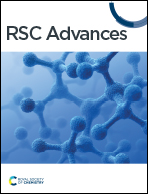Preparation of hydrophobic porous Au–Ag alloy nanoparticle arrays and their SERS properties†
Abstract
In this study, we prepared porous Au–Ag alloy nanoparticle arrays with hydrophobic surfaces through the polystyrene colloidal crystal template combined with the chemical etching method to realize rapid SERS detection for biochemical molecules. In the preparation process, the pore size of Au–Ag alloy nanoparticles could be adjusted by changing the deposition time of the Ag element. Furthermore, after depositing the Au film on the surface of the porous nanoparticle arrays, their surface changed from hydrophilic to hydrophobic. The hydrophobic surface can drive target molecules to locally aggregate. Meanwhile, the hydrophobic surface also possessed a large number of active “hot spots” due to the porous structure. For these reasons, the porous Au–Ag alloy nanoparticle arrays can enable rapid and trace SERS detection, which provide the material basis for the subsequent construction of the high-quality SERS substrate.



 Please wait while we load your content...
Please wait while we load your content...